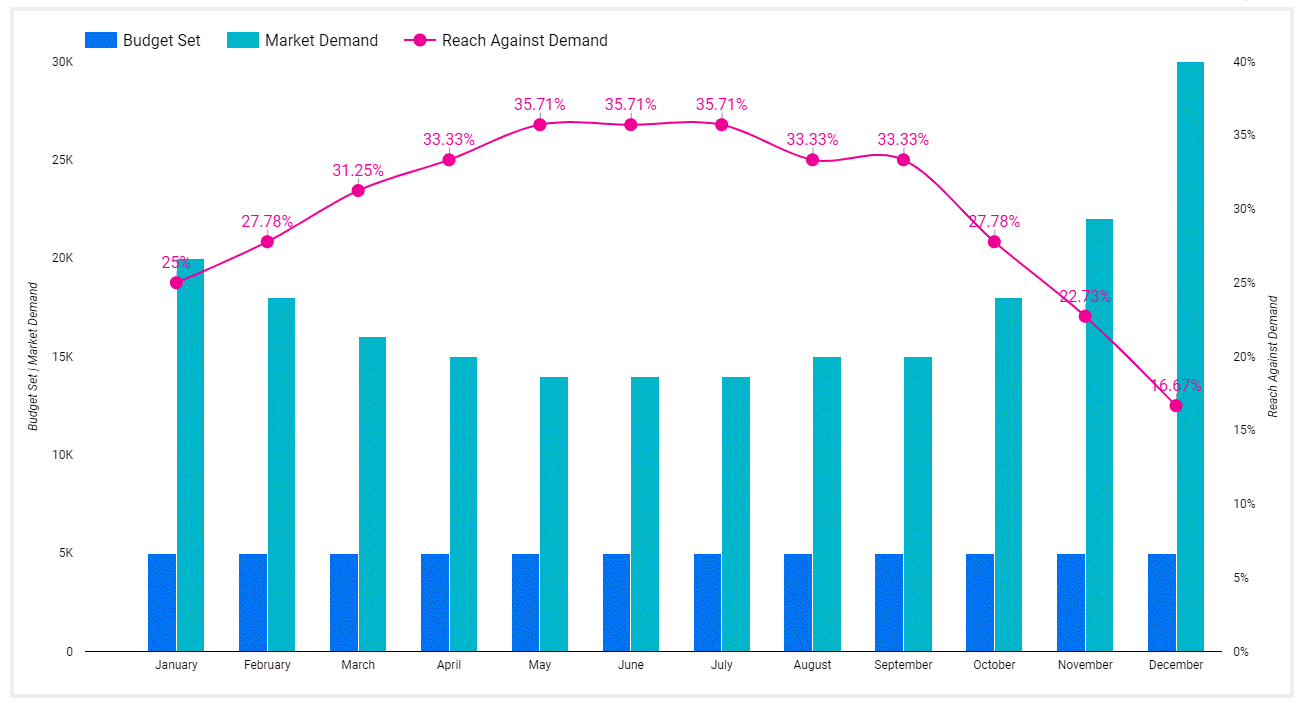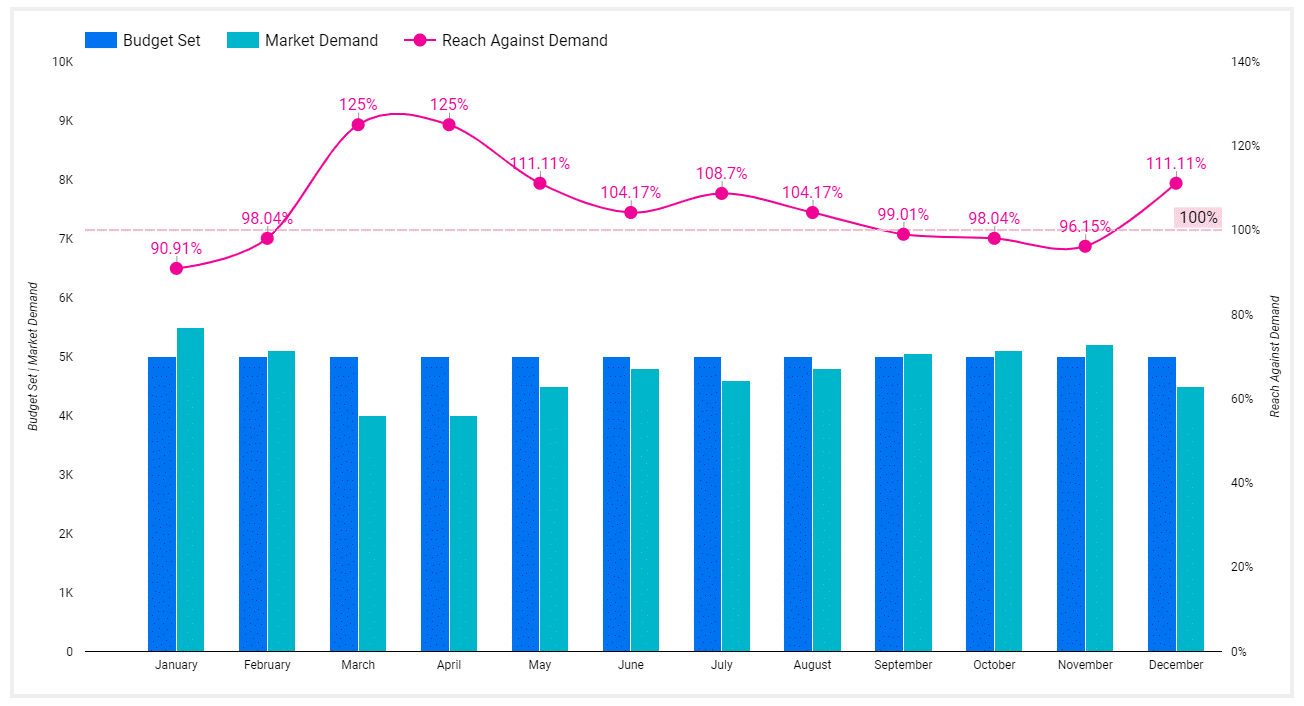How to Allocate Budgets to SEM
SEM is Search Engine Marketing, example: Google Search Ads. This article intended for SEM specialists.
It’s not unusual for a client to brief in the following kind of budget allocation:
“we want to allocate the following monthly budgets:”
- $150k on DOOH
- $50k on Programmatic display media on performance targeting
- $20k on FB, split $15k on reach targeting, $5k on remarketing.
- $20k on SEM, split $12k on Service range A, $8k on Service range B.
The underlying business objective (as with most) is to generate more revenue or profit.
The issue with this is as follows:
SEM is a demand-based channel. The others are not.
So, this raises the need for some method to establish the right SEM budget, based on demand.
This is a challenge because unless the client already fully understands the exact demand volume on SEM, then it’s not possible to establish how much could or should be spent on specific aspects of it, such as a Product Range type, or a specific Service offering.
Budgets for SEM need to be allocated based on a few business factors for sure, but also it is fundamentally constrained by the natural factor of demand, irrespective of what the business desires.
SEM Budget Example A:
If the monthly demand against Service Offering A is 1,000 Users per month, and the allocated budget is sufficient to reach 200 Users, then there will be 800 Users per month who cannot (will not) click on the ads for that Service and may not ever see the ads in the first place. In the same way that the client may ‘search for themselves and wonder why their ads are not showing’, budget is not sufficient to make this happen, 80% of the time.
The budget in this case can be fully spent, because the budget is only a proportion (20%) of the total market demand that month. Budget is outstripped by demand.

Chart above shows a client allocated budget of $5k per month, but a Market Capacity with seasonal shift much higher than the allocated budget, resulting in a variable Reach ranging from 17 to 36%, leaving between 64 to 83% of the Search Market Capacity unable to see any SEM ads from this advertiser.
SEM Budget Example B:
On the flip side, if there are 500 Users demanding the service in search for a month, but the allocated budget is enough to reach 1,000 Users’ worth of clicks, then its possible ads are shown to all 500 users. The budget will not be spent, and cannot ever be spent, because the demand doesn’t exist (yet).

Chart above again shows a client allocated budget of $5k per month, but now the Market Capacity is about the same or slightly below the allocated budget. Months where the solid pink line is above the 100% reference shows months where allocated budget cannot be spent. This might represent a typical Brand Campaign where the aim is to have enought budget to cover 100% of the Demand, but with enough variability that it’s still not as simple as allocating a fixed budget. Reaching 100% all of the time can only be achieved by setting a variable flexible budget and allow demand to use budget as demand occurs.
Side Note:
The task of Media ads are to raise demand.
Roughly half of all buying journeys start in Google Search. By logic, this means that SEM demand can be used as a yard stick for the success of Media ads. A lift in demand, suggests that other media may have driven it.
Back to the point of SEM budget allocation:
Now consider again the situation where demand for Service Offering A was 1,000 Users per month.
Experienced SEM operators will know where to recommend a Budget point to reach X% of those users based on the type of conversion that might be recorded and the kind of Keywords and Market Competition exists for Service Offering A.
In a highly competitive niche, the SEM operator probably knows that reaching above 80% of the Market Capacity (Demand) delivers severely reduced returns. i.e. it becomes very expensive to compete for the last 20% of the market. So, the SEM operator might recommend a budget that reaches say 70-80% of the Market Capacity and no more.
Protecting Brand in SEM is relatively cheap, has a reasonably predictable Market Capacity, and provides an advertiser with a clear advantage over competitors because their Brand is THE Brand advertised. In this case, the SEM operator might recommend a budget that reaches 100% of the Market Capacity, because the returns tend not to diminish against Brand Keywords.
SEM Budget Example C:
In a final example, the SEM operator may also be tasked with adverting against Service Offering B.
Let’s say Service Offering B has a Market Capacity of 10,000 Users, and the client allocates a budget to reach 2,000 Users, i.e. 20% of Market Capacity. Let’s also say that Service Offering B delivers more revenue or more margin than Service Offering A, per sale. In this case, not only is Reach limited, but so is potential revenue, by allocating budget to Service Offering A that could be across Service Offering B. So, the % budget split between A and B Services becomes a decision that doesn’t align with the underlying business objective.
In many cases, the client may not realise that:
- their budget totals are not proportional to areas of return on investment
- their budget splits are or are not limited by Market Capacity and may or may not be able to be spent or may or may not be best spent elsewhere.
For this reason, the SEM operator may be best placed to determine SEM budget allocations.
Other value exists in SEM though:
For example:
- The value of exposure against competitor terms when Users search for a Brand that offers the same Service as you.
- The value of Protecting your Brand in SEM against advertisers that also do the above point, either with paid or organic search.
- The value of being seen in search by Users who don’t yet know your Brand or have no current Brand awareness against a given Service or Product Offering.
These factors may determine whether Return On Ad Spend (ROAS) or total Revenue are not the most important performance criteria for SEM.
Complications to setting the right SEM budget:
Market demand may shift for many reasons.
As previously stated, Media spend may increase market demand in some aspects of SEM, so SEM can be used as a yardstick to measure the success of the other channels.
Other factors on market demand are:
- Competitor marketing activity
- Seasonal trends
- Press exposure, or influencer exposure
- Wider market forces like cost of living, inflation, weather, war.
- Etc
The SEM operator can measure this effect on search in terms of how demand changes but can’t predict it.
Another issue, and a very complex one, is the affect of Attribution. Knowing that SEM tends to be (but not always) at the lower position in a conversion funnel, easy pickings of ROAS and Revenue seem attractive, but without recognising that User Journeys are complex, budget could be allocated in a way that creates a self-defeating reduction of success and ultimate loss of Brand Equity. The task is therefore not just one of SEM analysis but also one of Analytics.
In the attribution analysis, it is even possible to discover that a business could multiply their revenue or ROAS by a simple shift in SEM budget. Understanding BOTH Market Capacity AND Attribution can assist with rapid business growth from existing channels, and with relatively minor changes.
In summary:
- Budget cannot be spent beyond the total of the Market Capacity, so assigning budget beyond that cap is pointless and best spent elsewhere.
- The experienced SEM operator will know how to determine Market Capacity and is therefore well placed to advise on Budget allocations based on agreed objectives.
- Budget allocations could be seemingly distributed contrary to underlying business objectives of revenue lift, but even if so, are still constrained by Market Capacity.
- Huge business wins could be achieved by a deeper understanding of BOTH Market Capacity and Attribution combined.
Article is Copyright©. Written using NI (Natural Intelligence using brain interface with fingers and keyboard).

